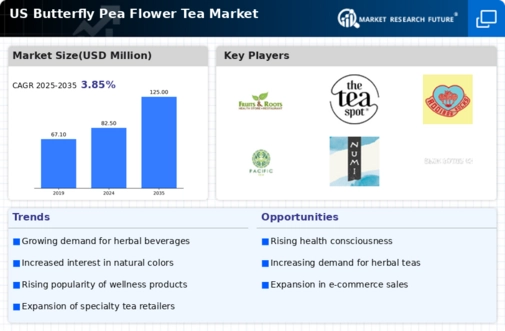Rising Demand for Herbal Teas
The butterfly pea-flower-tea market experiences a notable increase in demand as consumers gravitate towards herbal teas, driven by a growing awareness of health benefits. This trend is reflected in market data, indicating that herbal tea consumption in the US has surged by approximately 20% over the past five years. The appeal of butterfly pea flower tea lies in its antioxidant properties and potential health benefits, which resonate with health-conscious consumers. As more individuals seek natural alternatives to traditional beverages, the butterfly pea-flower-tea market is poised for growth. This shift towards herbal options is not merely a passing trend; it appears to be a fundamental change in consumer preferences, suggesting a long-term opportunity for brands to capitalize on this burgeoning interest.
Expansion of E-commerce Platforms
The butterfly pea-flower-tea market is significantly influenced by the expansion of e-commerce platforms, which facilitate easier access to a wider range of products. As online shopping continues to gain traction, consumers are increasingly turning to digital channels for their tea purchases. Recent statistics indicate that e-commerce sales in the beverage sector have grown by over 30% in the past year alone. This shift not only broadens the consumer base for butterfly pea-flower tea but also allows brands to reach niche markets that may have been previously underserved. The convenience and variety offered by e-commerce platforms are likely to enhance the visibility and sales of butterfly pea-flower tea, driving market growth in the coming years.
Health-Conscious Consumer Behavior
The butterfly pea-flower-tea market is positively impacted by the health-conscious behavior of consumers, who are increasingly prioritizing wellness in their dietary choices. This trend is evident in the rising sales of functional beverages, which have seen an increase of approximately 25% in the last three years. Consumers are actively seeking products that offer health benefits, such as improved digestion and enhanced immunity. Butterfly pea flower tea, known for its antioxidant properties and potential to reduce stress, aligns well with these preferences. As the market continues to evolve, brands that emphasize the health benefits of butterfly pea-flower tea are likely to resonate with a growing segment of health-oriented consumers, further propelling market growth.
Increased Interest in Natural Colorants
The butterfly pea-flower-tea market benefits from the rising interest in natural colorants, particularly among food and beverage manufacturers. The vibrant blue hue of butterfly pea flower tea, derived from anthocyanins, offers an appealing alternative to synthetic colorants. Recent data indicates that the natural food colorant market in the US is projected to grow at a CAGR of 7% through 2027. This trend aligns with consumer preferences for clean-label products, as they increasingly seek transparency in ingredient sourcing. Consequently, the butterfly pea-flower-tea market stands to gain traction as manufacturers incorporate this natural ingredient into their offerings, enhancing product appeal while meeting consumer demand for healthier options.
Growing Popularity of Exotic Ingredients
The butterfly pea-flower-tea market is witnessing a surge in popularity due to the increasing consumer fascination with exotic ingredients. As consumers become more adventurous in their culinary choices, they are drawn to unique flavors and colors that stand out. Market Research Future suggests that the demand for exotic teas has risen by approximately 15% in the last two years. This trend is particularly pronounced among millennials and Gen Z consumers, who are eager to explore new taste experiences. The butterfly pea flower, with its striking appearance and potential health benefits, aligns perfectly with this trend, positioning the market for substantial growth as it caters to the evolving preferences of a diverse consumer base.


















Leave a Comment